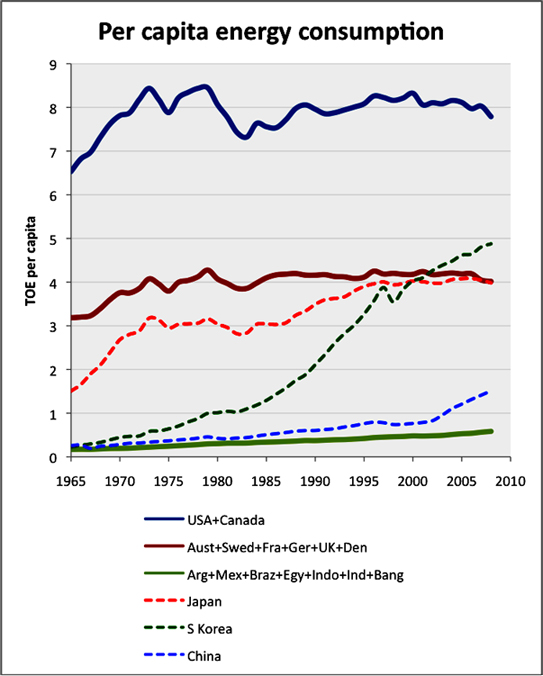Pops wrote:That's a good article Kub but it leaves out one thing and of course that's energy and more to the point, peak energy.
All the economic philosophers since the industrial revolution have taken for granted that energy growth will continue forever the article merely overlays the idea that no growth would be a choice. You and I both agree that we won't have the luxury of making a choice, growth will stop when the oil slaves are gone.
No, his point was that capitalism cannot survive in a no growth scenario. Not that growth is a choice:
Daly and the anti-growth school are certainly right that we need to break out of the “iron cage of consumerism,” “downshift” to a simpler life, find meaning and self-realization in promoting the common good instead of accumulating stuff. They call for an environmentally rational economy that conserves nature and resources for the benefit of our children and theirs, instead of consuming the whole planet right now. They call for a redistribution of wealth to those in need and for the construction of a society based not on possessive individualism but on a decent material sufficiency for everyone on the planet. And they call for a moral and spiritual transformation of our values away from materialism. Those are admirable goals. But we can’t do any of those things under capitalism because under capitalism, we’re all just rats racing in Paul Krugman’s cages. We can’t stop consuming more and more because if we stop racing, the system collapses into crisis. So it follows that we need a completely different kind of economic system, a non-capitalist economic system based on human needs, environmental needs, and a completely different value system, not on profit.
The author also mentions energy and states that even if we replaced all of those oil slaves with clean renewable energy, we would still have a problem:
In Growth Isn’t Possible Simms and his co-author Victoria Johnson reviewed all the existing proposed models for dealing with climate change and energy use including renewable, carbon capture and storage, nuclear, and even geo-engineering, and concluded that these are “potentially dangerous distractions from more human-scale solutions” and that there are “no magic bullets” to save us. The report concludes that even if we were to rapidly transition to an entirely clean energy -based economy, this would not suffice to save us because: “Globally, we are consuming nature’s services – using resources and creating carbon emissions – 44 percent faster than nature can regenerate and reabsorb what we consume and the waste we produce. In other words . . . if the whole world wished to consume at the same rate it would require 3.4 planets like Earth.” Given these facts and trends, Simms and Johnson argue, we have no choice but to bring average global growth to a halt
Pops wrote:But luckily, every argument put forth by the author against no growth capitalism doesn't outline something concrete to prevent it but only of things desired; shareholders want growth, producers want higher profits, corporations want to expand, consumers want more possessions. Well of course we do, we're greedy shortsighted monkeys - what should we expect?
You missed the flipside of the coin to all of that monkey greed. Sure, you can take tell the shareholders to piss off, the consumers they can't have anymore toys. But in the same breath, you are also advocating all of the associated ills that occur when a capitalist economy goes into stasis or reverse:
Of course there are times when capitalist economies do slow down, and grind along in a sort of stasis -- but that’s even worse. Since the fall of 2008 when the world economy suddenly ground to a halt, we’ve been treated to a preview of what a no-growth stasis economy would look like under capitalism. It’s not a pretty sight: capital destruction, mass unemployment, devastated communities, foreclosures, spreading poverty and homelessness, school closures, and environmental considerations shunted aside in the all-out effort to restore growth. That is “stasis” under capitalism. In one of his books, Daly wrote with some exasperation, “must we [grow] beyond the optimum, just to keep up the momentum of growth for the sake of avoiding unemployment?” Well, yes actually, because under capitalism workers don’t have job security like tenured professors. This fact may partially explain why it is that, despite all the anti-growth books published since the 1970s, there is no public support out there for a capitalist steady-state economy. And why should there be? Why would anyone want a steady-state capitalist economy? Poll after poll shows that ordinary citizens want to see the environment cleaned up, want to see a stop to the pillage of the planet, the threat of destruction of their children’s future. But as workers in a capitalist economy, “no growth” just means no jobs. If limits to growth are imposed, and some industries have to cut back, where would laid-off workers find re-employment? And if the economy does not continuously grow (quantitatively), where would the jobs come from for the workers’ children? Today, in the United States, there are said to be at least seven applicants for every available job. Where are those other six people going to find jobs if there is no growth? And this situation is far worse in the developing world where unemployment levels are off the charts. So throughout the world, given capitalism, the only hope for workers is more growth. As a recent headline in the satirical weekly The Onion ran: “Masses Clamor for New Bubble.”
Pops wrote:Anyway, since we agree reverse growth will not be a choice but a given, what then? The author gives the answer and it's right along the lines of Smith
I think you misread what that author was saying there. He wasn't listing those things as a viable alternative to growth capitalism. He listed those things as an exception to the rule, because they have no competition. If all of a sudden we have legions of unemployed because the growth sector of capitalism is shrinking and laying off workers, do you expect all of them to start or work for mom & pop shops? Remember the earlier quote that for every job opening there were seven applicants? These guys don't have the capital to start their own business. And even if they did, if all of a sudden there was suddenly six new competitors springing up for existing mom & pop shops, how long would they stay in business?
The oil barrel is half-full.








 ) I'm left with the impression that we are not becoming more efficient at all, in fact our transport is less efficient and our housing is just treading water.
) I'm left with the impression that we are not becoming more efficient at all, in fact our transport is less efficient and our housing is just treading water.


 )
)


